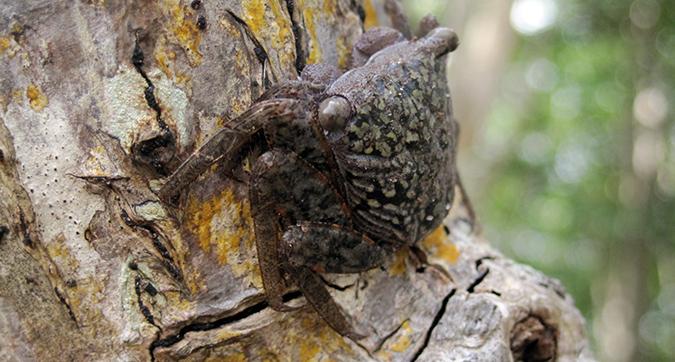
Annapolis, Md — The mighty mangrove tree crab can climb, it can jump … and it may very well rewrite our understanding of who’s eating what (and why) below the water’s surface.
A new study by Lauren Yeager, postdoctoral fellow at the National Socio-Environmental Synthesis Center (SESYNC), and colleagues provides insight into a unique predator–prey interaction that spans from water to land. Combining field observations and controlled experiments, the researchers found that mangrove tree crabs leap from tree canopies into the water below to escape bird predators, and migrate up trees to escape fish predators during high tide.
By avoiding one predator, however, these crustaceans make themselves more vulnerable to another—so the crabs mediate their response when both bird and fish threats are present. To dodge the immediate threat of birds while still evading the looming threat of fish, crabs hide in lower mangrove roots or move into protected marsh areas.
A scientific paper based on the research, which Yeager led while working on her doctoral degree at Florida International University, was published online December 6 in the Journal of Experimental Marine Biology and Ecology. Yeager’s co-authors are Elizabeth Stoner, Loxahatchee River District; Joseph Peters, Portland State University; and Craig Layman, North Caroline State University.
“Crabs jumping from trees is a cool behavior in and of itself. But what’s really interesting is that this behavior links terrestrial and aquatic food webs. And because the behavior changes depending upon predator threat level, so does the magnitude of that link,” said Yeager.
Current thinking suggests that mangrove food webs are divided systems: below water, fish feed on algae or seagrass; above water, insects feed on green mangrove leaves. Mangroves leaves that fall into the water aren’t an important food source for marine life, so scientists assumed mangroves themselves aren’t supporting marine food webs.
But Yeager’s research changes that. Apart from insects, mangrove tree crabs are the only animal to feed on green mangrove leaves in the Caribbean. When hungry birds drive these crabs into the water below, they become lunch for snappers and other fishes. The researchers’ diet studies of snapper, one of the most dominant fish predators in mangroves, found that mangrove tree crabs represent up to 30% of the fishes’ diet.
And therein lies the important link between terrestrial and aquatic food webs: snappers’ direct consumption of crabs and indirect consumption of green mangrove leaves is controlled, at least in part, by crabs fleeing from bird attacks. This also likely explains why the crabs spend most of their time out of water: fish are always present, and they’re always a threat.
Yeager says the research also highlights broad implications for conservation.
“Heron species prey upon mangrove tree crabs, but they also face threats of their own, such as the loss of wetland habitat due to development of coastal areas. If our activities cause harm to herons, we now know there are cascading ramifications for snapper through their diet,” she explained.
Above photo: Mangrove tree crab courtesy Lauren Yeager.
Media Contact
Melissa Andreychek
Communications Coordinator, SESYNC
mandreychek@sesync.org
(410) 919-4990
###
The National Socio-Environmental Synthesis Center, funded through an award to the University of Maryland from the National Science Foundation, is a research center dedicated to accelerating data-driven scientific discovery at the interface of human and ecological systems. Visit us online at www.sesync.org and follow us on Twitter @SESYNC.